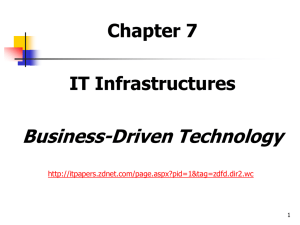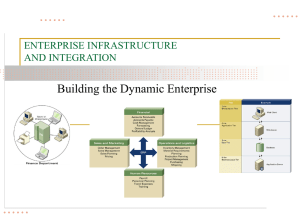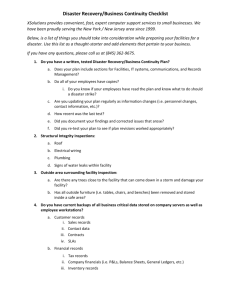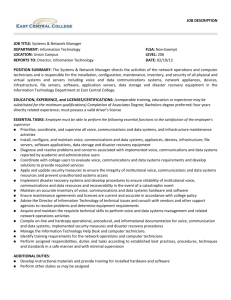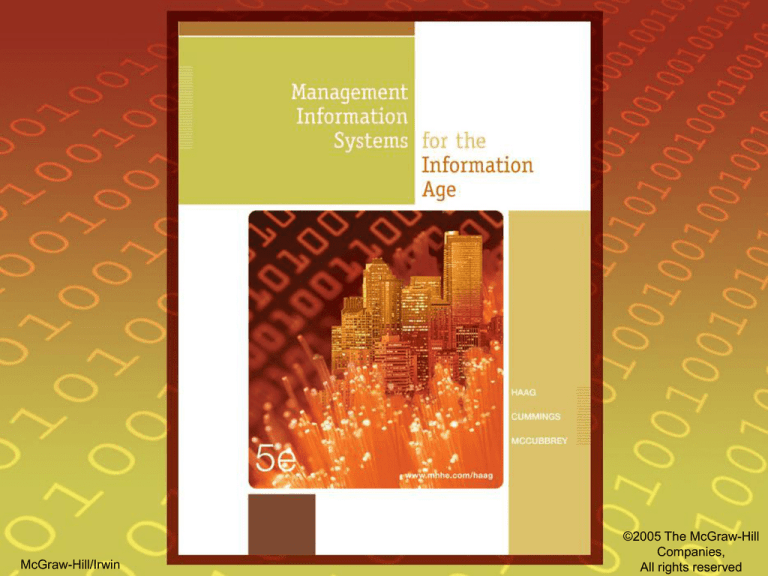
McGraw-Hill/Irwin
McGraw-Hill/Irwin
©2005 The McGraw-Hill
Companies,
©2005 The McGraw-Hill Companies, All rights reserved
All rights reserved
Chapter 7
IT INFRASTRUCTURES
Business-Driven
Technologies
McGraw-Hill/Irwin
©2005 The McGraw-Hill Companies, All rights reserved
OPENING CASE STUDY
• Make the Call
• Many people are using the Internet to make
free phone calls
• Voice over Internet protocol (VoIP) is the
technology that makes Internet phone calls
possible
• VoIP transmits over 10 percent of all phone
calls
7-3
OPENING CASE STUDY
• Many vendors are offering VoIP
• All vendors are providing the same service,
but depending on their IT infrastructure the
service features vary significantly from
vendor to vendor
7-4
STUDENT LEARNING OUTCOMES
1. Explain the relationship between the
organization’s roles and goals and the IT
infrastructure
2. Describe the difference between a 2-tier
and 3-tier infrastructure
3. Describe system integration
7-5
STUDENT LEARNING OUTCOMES
4. Describe Web services and Microsoft’s
.NET
5. Explain the difference between network
area storage (NAS) and storage area
networks (SAN)
6. List and describe the seven “-ilities”
7-6
INTRODUCTION
Organizations can choose from thousands of
components to build their IT infrastructures
IT infrastructure - includes the hardware,
software, and telecommunications equipment
that, when combined, provide the underlying
foundation to support the organization’s goals
7-7
INTRODUCTION
7-8
IT INFRASTRUCTURE OVERVIEW
•
The three primary components of any IT
infrastructure include:
1. Client/server networks
2. Internet
3. N-tier infrastructures
7-9
Client/Server Network
•
Client/server network - a network in which
one or more computers are servers and
provide services to the other computers,
which are called clients
–
Thin client - a workstation with a small amount
of processing power and costs less than a full
powered workstation
7-10
Client/Server Network
7-11
The Internet
• There are numerous ways that the Internet
enables an organization’s success
• Organizations must watch for inappropriate
use of the Internet by its employees
• Organizations must decide how employees
will access the Internet
7-12
n-Tier Infrastructures
• Basic client/server computing is a 2-tier
infrastructure
– 2-tier infrastructure – there are only two tiers –
the client and the server
– 3-tier infrastructure – contains clients,
application servers, and data servers
7-13
Additional IT Infrastructure Elements
• Client/server networks, the Internet, and ntier infrastructures are central to an
organization’s IT infrastructure
• Three general categories of additional IT
infrastructure elements include:
– Information views
– Business logic
– Data storage and manipulation
7-14
Additional IT Infrastructure Elements
7-15
INFORMATION VIEWS
• Responsible for the presentation of
information and receiving user events and
includes:
–
–
–
–
Intranets
Extranets
Portals
Digital dashboards
7-16
INFORMATION VIEWS
• Intranet - an internal organizational Internet
that is guarded against outside access by a
special security feature called a firewall
(which can be software, hardware, or a
combination of the two)
• Extranet – is an intranet that is restricted to
an organization and certain outsiders, such
as customers and suppliers
7-17
INFORMATION VIEWS
• Enterprise information portals (EIPs) - allow
knowledge workers to access company
information via a Web interface
– Collaborative processing enterprise information
portal - provides knowledge workers with access to
workgroup information
– Decision processing enterprise information
portal - provides knowledge workers with corporate
information for making key decisions
7-18
INFORMATION VIEWS
• Digital dashboard – displays key information
gathered from several sources on a computer
screen in a format tailored to the needs and
wants of an individual knowledge worker
7-19
INFORMATION VIEWS
7-20
BUSINESS LOGIC
• Responsible for maintaining the business
rules (e.g. application software) and
protecting corporate information from
unauthorized direct access by the clients and
includes:
–
–
–
–
Integrations
Web services
Workflow systems
Applications service providers
7-21
BUSINESS LOGIC
Integrations solve the problem with separate
applications
Integration - allows separate applications to
communicate directly with each other by
automatically exporting data files from one
application and importing them into another
7-22
BUSINESS LOGIC
7-23
BUSINESS LOGIC
• Web Services promise to be the next major
frontier in computing
– Web services – encompass all the technologies
that are used to transmit and process information
on and across a network
– Interoperability – the concept that different
computer systems and applications can talk to
each other
7-24
BUSINESS LOGIC
• Microsoft .NET - .Net is Microsoft’s version
of Web services
• Microsoft’s vision is to make applications
available any time, any place, on any device
7-25
.NET Components
The three primary components of .NET:
– .NET platform – tools, technologies, and
services that support .NET
– .NET framework – supports Web services
– Visual Studio .NET – development tools that
create .NET applications
7-26
BUSINESS LOGIC
• Many companies support Web Services
besides Microsoft
• Primary competitor is Sun Microsystems
J2EE
• Java 2 Enterprise Edition (J2EE) – Sun
Microsystems development tool for building
Web Services applications
7-27
BUSINESS LOGIC
• Workflow systems help to automate the
process of presenting and passing
information around an organization
• Workflow - defines all of the steps or
business rules, from beginning to end,
required for a process to run correctly
• Workflow systems - automate business
processes
7-28
BUSINESS LOGIC
Two primary types of workflow systems include:
– Messaging-based workflow systems - send
work assignments through an e-mail system
– Database-based workflow systems - store the
document in a central location and automatically
asks the knowledge workers to access the
document
7-29
BUSINESS LOGIC
An organization can outsource business logic
through an application service provider
Application service provider (ASP) – supplies
software applications over the Internet that would
otherwise reside on its customers’ in-house
computers
7-30
ASP Configuration
7-31
BUSINESS LOGIC
Customers typically sign an agreement with
the ASP for service
Service Level Agreements (SLAs) - define the
specific responsibilities of the service provider
and set the customer expectations
7-32
DATA STORAGE AND MANIPULATION
• Responsible for data storage and
manipulation and includes:
–
–
–
–
Network area storage
Storage area networks
Server farms
Collocation
7-33
DATA STORAGE AND MANIPULATION
• Network area storage (NAS) – is a special
purpose server aimed at providing file
storage to users who access the device over
a network
7-34
DATA STORAGE AND MANIPULATION
• Storage area network (SAN) – is an
infrastructure for building special, dedicated
networks that allow rapid and reliable access
to storage devises by multiple servers
7-35
SAN Configuration
7-36
DATA STORAGE AND MANIPULATION
• NAS and SAN architectures share several
objectives including:
– Large amounts of storage capacity
– Serve multiple users
– 24 X 7 support
• Primary difference is the location of the
network that connects users, file servers, and
disk drives
7-37
DATA STORAGE AND MANIPULATION
• Server farm - the name of a location that
stores a group of servers in a single place
• Web farm – is either a Web site that has
multiple servers or an ISP that provides Web
site outsourcing services using multiple
servers
7-38
DATA STORAGE AND MANIPULATION
• Collocation - a company rents space and
telecommunications equipment from another
company, or a collocation vendor
• Collocation facilities typically contain server
farms and Web farms
7-39
SUPPORTING AN IT
INFRASTRUCTURE
• An organization can support its IT
infrastructure components with:
– Backup/recovery
– Disaster recovery
– Infrastructure ‘ilities
7-40
SUPPORTING AN IT
INFRASTRUCTURE
• Backup - the process of making a copy of
the information stored on a computer
• Recovery - the process of reinstalling the
backup information in the event the
information was lost
7-41
SUPPORTING AN IT
INFRASTRUCTURE
• Disaster recovery plan - a detailed process
for recovering information or an IT system in
the event of a catastrophic disaster such as a
fire or flood
• A disaster recovery plan typically includes hot
and cold sites
7-42
Hot and Cold Sites
• Hot site - a separate and fully equipped
facility where the company can move
immediately after the disaster and resume
business
• Cold site - a separate facility that does not
have any computer equipment, but is a place
where the knowledge workers can move after
the disaster
7-43
SUPPORTING AN IT
INFRASTRUCTURE
•
Disaster recovery cost curve – charts
1. The cost to your organization of the
unavailability of information and technology
2. The cost to your organization of recovering from
a disaster over time
7-44
Disaster Recovery Cost Curve
7-45
SUPPORTING AN IT
INFRASTRUCTURE
• Factors to consider when developing an IT
infrastructure (These factors are commonly
referred to as the ‘ilities)
–
–
–
–
–
–
–
Availability
Accessibility
Reliability
Scalability
Flexibility
Performance
Capacity planning
7-46
SUPPORTING AN IT
INFRASTRUCTURE
• Availability - determining when your IT
system will be available for knowledge
workers to access
• Accessibility - determining who has the right
to access different types of IT systems and
information
7-47
SUPPORTING AN IT
INFRASTRUCTURE
• Reliability - ensures your IT systems are
functioning correctly and providing accurate
information
– Data cleansing - the process of ensuring that all
information is accurate
7-48
SUPPORTING AN IT
INFRASTRUCTURE
• Scalability – how well your system can adapt
to increased demands
• Flexibility - the system’s ability to change
quickly
7-49
SUPPORTING AN IT
INFRASTRUCTURE
• Performance - measures how quickly an IT
system performs a certain process
– Benchmark – baseline values a system seeks to
attain
– Benchmarking – a process of continuously
measuring system results
7-50
SUPPORTING AN IT
INFRASTRUCTURE
• Capacity planning - determines the future
IT infrastructure requirements for new
equipment and additional network capacity
7-51
IT INFRASTRUCTURES AND THE
REAL WORLD
• When approving designs for an IT infrastructure
be sure to ask the following:
–
–
–
–
–
How big is your department going to grow?
Will the system handle additional users?
How are your customers going to grow?
How easy is it to change the system?
How flexible is the system?
7-52
IT INFRASTRUCTURES AND THE
REAL WORLD
– How much additional information do you expect to
store each year?
– How long will you maintain information in the systems?
– How much history do you want to keep on each
customer?
– What are the hours you need the system to be
available?
– How often do you need the information backed up?
7-53
CAN YOU…
1. Explain the relationship between the
organization’s roles and goals and the IT
infrastructure
2. Describe the difference between a 2-tier
and 3-tier infrastructure
3. Describe system integration
7-54
CAN YOU…
4. Describe Web services and Microsoft’s
.NET
5. Explain the difference between network
area storage (NAS) and storage area
networks (SAN)
6. List and describe the seven “-ilities”
7-55
CHAPTER 7
End of Chapter 7
McGraw-Hill/Irwin
©2005 The McGraw-Hill Companies, All rights reserved

